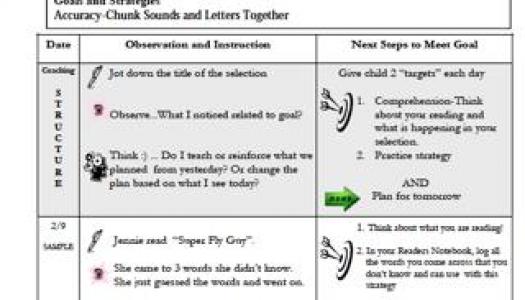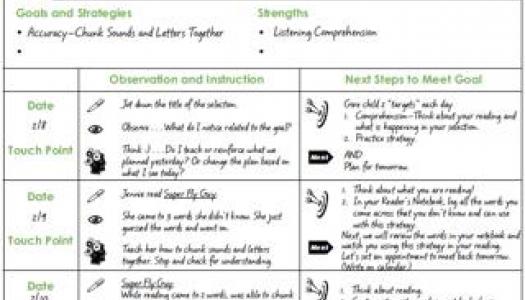Feedback—An Essential Ingredient in Conferring
Join Our Community
Access this resource now. Get up to three resources every month for free.
Choose from thousands of articles, lessons, guides, videos, and printables.
.jpg)
In our personal lives as well as our work lives, most of us ask for feedback on a frequent basis. We may ask, "How did my presentation go today at the faculty meeting?" or "What did you think of my speech to the PTA last night?" We can benefit from feedback that is honest and helps us become better. Adults need feedback to gauge what they are doing well and to know the areas in which they can improve. Students need feedback, too, for the same reasons. In fact, feedback followed by appropriate student action is one of the foundations of the CAFE Assessment System (Boushey & Moser, 2009).
In the CAFE system, the teacher's role during conference times is to offer feedback to students who are trying to achieve their goals. Teachers who are just beginning to put into practice the principles of conferring in CAFE may ask themselves, "What is effective feedback?" Those who are veterans in the area of conferring may ask the very same question. Is effective feedback the same as good advice? Does writing "good" on a child's paper or saying "Great job" in a conference constitute effective feedback? Or is it something much more?
Researcher Grant Wiggins (2012) attempts to answer this crucial question in his article "Seven Keys to Effective Feedback." According to Wiggins, effective feedback possesses these characteristics: "goal-referenced; tangible and transparent; actionable; user-friendly (specific and personalized); timely; ongoing; and consistent." His comment that "Effective feedback requires that a person has a goal, takes action to achieve the goal, and receives goal-related information about his or her action" reinforces the important relationship between the target goal and feedback.
To be successful in guiding students toward their goals, effective practitioners of conferring in CAFE have to understand how to give feedback that is purposeful and valuable. As teachers, we have to avoid the pitfalls of giving feedback in the forms of evaluation and advice. To demonstrate feedback done right, Wiggins uses an example from Harvard University physics professor Eric Mazur. In teaching introductory physics to 200 students, Mazur assigns problems for them to tackle individually and then discuss in small groups. Through this approach, he is able to maximize feedback between students and instructor. By examining student responses to the problems, Mazur can gauge how well they understand the class content. He avoids the traditional college lecture format of one professor addressing 200 students and instead personalizes the learning experience through small-group work and effective feedback from teacher and peers.
How does effective feedback fit in with the CAFE system of assessment? How can it fit in with my individual conferencing?
Key 1: Goal referenced. The first key that Grant Wiggins describes is goal referenced. This concept fits in very well with CAFE because each student is working toward an achievable goal of his or her own choosing. The goal is drawn from the child's assessment results. In conferring with a child about his or her goal, the teacher continually goes back to what the child wants to achieve and offers a carefully sequenced way to achieve it. I can use this approach by always focusing on the student's goal when conferring.
Key 2: Tangible and transparent. Wiggins uses the terms tangible and transparent to describe the second key to effective feedback. In the CAFE Assessment System, the learner selects a clear goal and, with teacher guidance, works toward it. The teacher looks for tangible evidence of progress during conferring. If the child is experiencing difficulty meeting the goal, she offers additional support. When I confer, I will look for evidence that the child is approaching or meeting the goal.
Key 3: Actionable. Wiggins uses the term actionable to describe specific feedback that promotes further work and discovery on the learner's part. By meeting with the student as dictated by his needs, the teacher communicates with the child about his goal and records concrete, specific information about how he is working toward it. Together they discuss concrete actions that the learner can undertake to reach his goal. When the teacher schedules another appointment with the child, she can check what actions he has taken to achieve the goal. In my practice, I have to encourage the child to plan the needed actions for success.
Key 4: User-Friendly. Most users of CAFE associate this system of student assessment with user-friendliness. After all, in addition to their book, The Sisters have created and continue to update a website with a vast number of articles, videos, and photographs to support users. To put the CAFE system into practice, all the teacher needs are student assessment results, a few conferring forms, a Pensieve, and foundational principles for training students in the CAFE Menu and goal setting. When conferencing, the teacher also relies on user-friendliness; for example, she follows the same structure in all of her conferences and ensures that she provides students with direct, practical feedback that they can act upon. When conversing with students, she uses language that they can readily understand. With deliberation, she chooses her words wisely and frames action items carefully in conferencing so that she does not overwhelm students.
Key 5: Timely: Wiggins acknowledges the relationship between timely feedback and goal achievement. The CAFE Assessment System also recognizes this relationship. To act on their goals, students need to discuss what they are doing to be successful at meeting their goal and identify anything that may be creating an obstacle to it. This is why the teacher confers with students on a frequent basis, keeping track of meeting times and setting appointments to ensure timely feedback. Feedback that is not timely has little value—it falls into the regrettable category of too little, too late. This reinforces my commitment to providing timely feedback and offering students the opportunity to discuss and provide feedback to each other as well.
Key 6: Ongoing: The CAFE Assessment System offers students ongoing feedback. Students have the opportunity to apply what they are learning in independent reading, strategy groups, guided reading groups, and with the whole class. When they confer with the teacher, children report how they are using the feedback they have received to reach their goals. My interactions with students should reinforce their beliefs that learning is ongoing and continuous as we strive toward our goals.
Key 7: Consistent. When describing the final characteristic of effective feedback, Wiggins uses the word consistent. Consistency is the foundation of the CAFE Assessment program. Children's work always revolves around working toward a self-selected goal from the CAFE Menu; procedures such as declaring a goal and conferring with the teacher are governed by consistency. In the same way, the teacher's actions are also consistent when she confers. In conferences, she follows a protocol, coaching students toward a goal and helping them identify steps toward that goal. My conferring work with students should exhibit this same consistency.
Whenever I read about one of The Sisters' conferences in The CAFE Book or watch one of the conference videos on their website, I am struck by the fact that they put Wiggins's observations of effective feedback to excellent use. They follow his advice about offering feedback: "Always add a mental colon after each statement of value" (Wiggins, 2012, p. 15). Watching The Sisters confer shows how they take the generic statement "Good work" and make it more meaningful to the student by adding a specific comment that describes explicitly what the child did well. When offering feedback, I will follow their excellent model along with Wiggins's insights about the nature of effective feedback.
References
Boushey, G., & Moser, J. (2009). The CAFE book. Portland, ME: Stenhouse.
Wiggins, G. (2012). Seven keys to effective feedback. Educational Leadership, 70(1). Retrieved from http://www.ascd.org/publications/educational-leadership/sept12/vol70/num....






